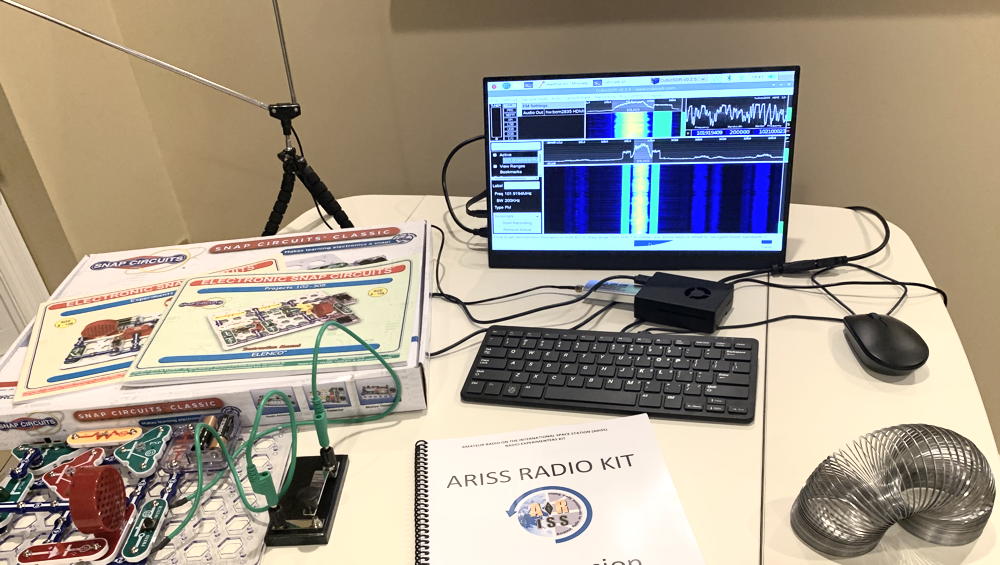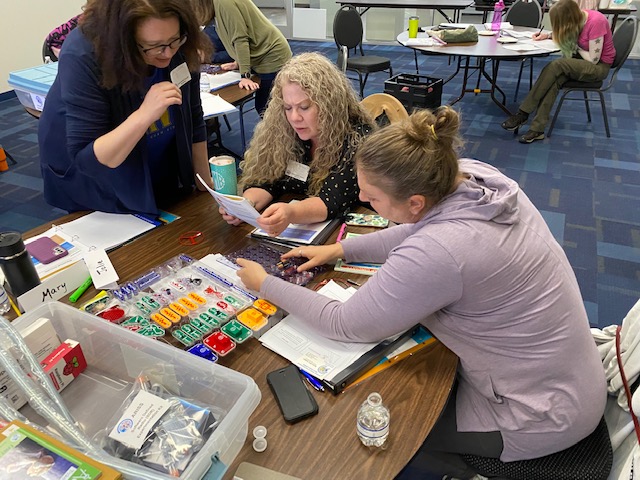ARISS SPARKs Kids’ Interest in Space
 For more than 20 years, Amateur Radio on the International Space Station (ARISS) has been connecting elementary, middle, and high school students with scientists and engineers aboard the International Space Station (ISS) using amateur radio. ARISS is involved from start to finish, including designing and building on-orbit amateur radio equipment, reviewing proposals for ARISS contacts (with a focus on disadvantaged youth and underrepresented communities), coordinating contact logistics, and promoting the results. Over the last two decades, more than 1,500 contacts have connected millions of school children to the ISS. 
For more than 20 years, Amateur Radio on the International Space Station (ARISS) has been connecting elementary, middle, and high school students with scientists and engineers aboard the International Space Station (ISS) using amateur radio. ARISS is involved from start to finish, including designing and building on-orbit amateur radio equipment, reviewing proposals for ARISS contacts (with a focus on disadvantaged youth and underrepresented communities), coordinating contact logistics, and promoting the results. Over the last two decades, more than 1,500 contacts have connected millions of school children to the ISS. 
Since 2019, ARDC has supported this work. Our first grant to the organization was $110,000 for the ARISS Next Generation Radio. This grant included funds to develop, test, and deploy a custom DC-DC power supply to produce the 13.8V required by small amateur radio transceivers from the 120V DC and 28V DC available on the ISS. This supply went into service in early 2020 and has been working flawlessly since.
In October 2021, ARDC awarded a $1.3 million grant to ARISS for the Student and Teacher Education via Radio Experimentation and Operations (STEREO) program. The goal of this five-year program is to not only continue scheduling and running ISS contacts, but also to improve the educational experience for students. ARISS is doing this in two ways:
- Sending educational wireless electronics kits to US and international schools to prepare for a radio contact with the ISS.
- Conducting workshops and outreach for teachers on how to use the kits, how to develop winning ARISS contact proposals, and learn about other space and amateur radio lessons they can bring into the classroom.
SPARKIng an interest in radio and electronics
Hams are hands-on learners, and that’s the focus of part one of the STEREO project. While teachers can and do conduct lessons using whiteboards, video, and other media, there’s no doubt that hands-on learning is more engaging and effective.

The Space-Pioneers Amateur Radio Kit Initiative (SPARKI) gives teachers the tools they need to teach about waves and frequency, basic electronics, codes and ciphers, and software-defined radio.
To provide teachers and students this hands-on experience, ARISS has developed a wireless electronics technology kit called the Space-Pioneers Amateur Radio Kit Initiative, or SPARKI, for short. According to Diana Schuler, STEREO Project Lead, SPARKI is aimed at middle and high school students and gives teachers the tools they need to teach about waves and frequency, basic electronics, codes and ciphers, and software-defined radio.
The kit includes:
- Regular and extra-long Slinkys to teach students about waves and how radio waves work.
- A Snap Circuits SC-300 kits to demonstrate basic electronics concepts like open, closed, series, and parallel circuits.
- A Morse Code key that can be coupled to a Snap Circuits project to learn about Morse code. This leads to additional lessons and games that introduce codes, ciphers and digital communications protocols.
- An RTL-SDR (Software Defined Radio) dongle and antenna that students will use to receive a variety of signals from terrestrial and orbiting sources (including the ISS).
- A Raspberry Pi 4B with 4 GB RAM, keyboard, power supply, and cables to demodulate and display data from the RTL-SDR.
- Amonitor with speakers: for display and sound.
- A 16 GB MicroSD Card with SPARKI-OS embedded software. Based on Raspian, this software allows teachers to get up and running quickly.
The kit will also include extensive lesson plans, developed by ARISS educators that teachers can use in their classrooms. Using the Raspberry Pi and RTL-SDR, teachers will be able to:
- Demonstrate the radio frequency spectrum using discrete displays of active radio bands from 500 kHz to 1.75 GHz.
- Receive and play commercial AM and FM broadcast stations and weather, aircraft and family radio service transmissions.
- Receive and play analog amateur radio voice communications, such as AM, Single Side Band (SSB), and FM, while also capturing voice and SSTV images from the ISS and other amateur radio satellites.
- Receive and display digital weak signal amateur radio communications signals like FT8 and Weak Signal Propagation Reporter (WSPR).
- Copy messages sent via the Automatic Packet Reporting System (APRS), including location and weather data.
- Display images received directly from National Oceanic and Atmospheric Administration (NOAA) satellites.
- Display telemetry received directly from other amateur satellites using the embedded FoxTelem program to downlink and decode amateur radio satellite telemetry as well as employ satellite orbit prediction tools, such a GPredict to track these satellites.
These capabilities are included out-of-the-box—without downloading and installing software or connecting to school networks or configuring network firewalls. Teachers can focus on lessons instead of tinkering with the hardware and software to get it to work. SPARKI-OS will, therefore, be easier to use in educational environments than other software currently available.
“This project was designed to get kids engaged in amateur radio and get them excited about it,” said Frank Bauer, KA3HDO, ARISS International Chair. “We feel that with SPARKI we are taking our educational efforts to the next level.”
Teaching the Teachers
To help teachers get the most out of SPARKI, ARISS plans to promote the program amongst the educational community and then hold training sessions that will help educators feel comfortable using it. One of the ways that ARISS is promoting the program is by reaching out to teachers at major educational conferences, such as the Space Exploration Educators Conference at Space Center Houston, and the National Science Teachers Association conference in Atlanta. “One of the things that this grant is helping us do is to reach out beyond the amateur radio community and interest teachers in other areas in our programs,” noted Bauer.
At these conferences, they are reaching teachers when they are most receptive to innovative classroom ideas. In addition to learning about SPARKI, they are educating the educators about how best to submit an ISS contact proposal.
Once they have grabbed a teacher’s attention, ARISS invites these teachers to attend an educator’s workshop. The SPARKI kit and the workshop is provided to the educators at no cost to them or their schools. These two-day workshops provide an in-depth, hands-on experience for educators by showcasing the ARISS STEAM educational capabilities that they can bring into the classroom.
The workshops will help the educators learn how the SPARKI kits work and how to integrate the material with other subjects. These workshops give the teachers the confidence they need to handle unexpected questions from students and troubleshoot problems with the equipment should they have them.
Putting SPARKI to the test
The ARISS STEREO team sponsored their first “Teach the Teacher” Radio Kit Workshop at the Computer Museum of America in Roswell, Georgia, on March 11-12, 2023. The purpose of this first workshop was to get the SPARKI kits and instructional materials into teachers’ hands so that they could gauge its effectiveness and collect suggestions for improvement.
Ten teachers from six schools, including elementary, middle school, and high school teachers, attended the workshop. Led by Schuler and ARISS educators Martha Muir and Rachel Jones, the teachers first learned about waves & frequency, basic electricity, and codes & ciphers. Each module included lab time so that teachers could experiment with the Slinkys, Snap Circuits, and other kit components. The teachers loved this aspect of the class, especially the Snap Circuits!
On day two, the teachers learned about software-defined radio (SDR). They each connected the kit’s RTL-SDR dongle to the Raspberry PI computer and were rewarded by getting a waterfall display on the monitor. They learned to zoom in to see details about the waterfall display and to listen to different radio signals on different frequencies.
Five members of the North Fulton (GA) Amateur Radio League joined ARISS on day 2. They helped give the teachers a taste of amateur radio and also gave a cool Tesla coil demonstration. At the conclusion of the workshop, the teachers were super excited to return home with their own radio kits for use in their classrooms.
According to Schuler, the workshop was a great success. The survey identified areas for improvement that ARISS will work on to make the next workshop even better. The next workshop will be held in conjunction with the 2023 Space Port Area Conference for Educators (SPACE) on June 21-23, 2023 at the Kennedy Space Center in Florida. Educators interested in attending a future workshop, especially those who have a keen interest in having an ARISS contact at their schools in the near future, should reach out to Diana Schuler for more details.
